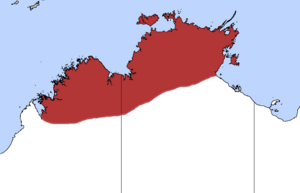Chestnut-backed buttonquail facts for kids
Quick facts for kids Chestnut-backed buttonquail |
|
|---|---|
 |
|
| Conservation status | |
| Scientific classification | |
| Genus: |
Turnix
|
| Species: |
castanotus
|
 |
|
| Distribution of the chestnut-backed buttonquail | |
| Synonyms | |
|
Hemipodius castanotus Gould |
|
The Chestnut-backed buttonquail (Turnix castanotus) is a special type of bird found only in Australia. It belongs to a bird family called Turnicidae.
Contents
About the Chestnut-backed Buttonquail
Discovering This Unique Bird
A long time ago, in 1840, a scientist named John Gould was the first to describe this bird. He studied a bird collected in northwestern Australia. Later, another scientist, George Gray, placed this bird into the group (genus) called Turnix. Its scientific name is Turnix castanotus.
What's in a Name?
The official name for this bird is the "Chestnut-backed buttonquail." This name was chosen by the International Ornithologists' Union. The word "castanotus" in its scientific name comes from ancient Greek words. Kastanon means "chestnut," and noton means "back." This perfectly describes the bird's chestnut-colored back!
Years ago, people often called these birds "quail." But in 1978, bird experts decided to use "buttonquail" to help people tell them apart from other types of quails.
Where Do They Live?
Australian Home Range
The Chestnut-backed buttonquail lives in northern Australia. You can find them from the Dampier Peninsula in Western Australia all the way to Westmoreland Station in northwestern Queensland. They might even be in places like Gregory Downs and Augustus Downs further east. These birds also live on Melville Island and Groote Eylandt.
They used to be common around Borroloola and McArthur River, but they are not seen there as much now. Scientists only confirmed that they live in Queensland in 2020.
Their Favorite Places to Be
These birds love to live in low grasslands and forests with Eucalyptus trees. They especially like rocky areas like sandstone ridges and plateaus. They often live in places that get a lot of rain in the summer, usually more than 800 millimeters (about 31 inches).
How They Behave
Reversed Roles in the Family
The Chestnut-backed buttonquail has a very interesting way of raising its young! In most bird species, the male is more colorful and helps with the eggs. But for buttonquails, it's the opposite! The female is usually larger and has brighter colors. She mates with several male partners.
After mating, the female leaves the males to do all the hard work. The male bird is in charge of sitting on the eggs to keep them warm. This is called incubating the eggs. The female lays a clutch of 1 to 5 eggs, but usually it's 4. These eggs are shiny white with small dark spots.


